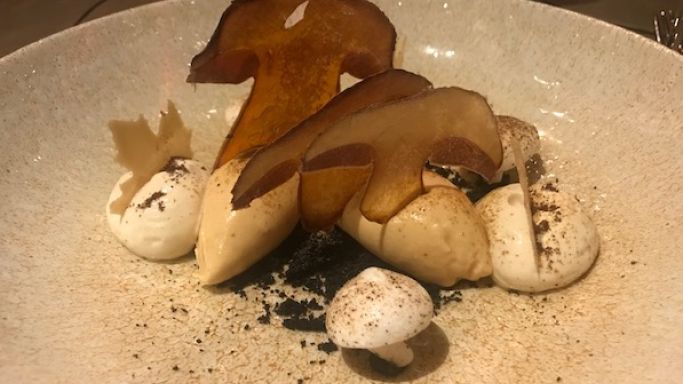A version of this article about a particularly fine Belgian restaurant is published by the Financial Times.
I have for many years known that the Belgians take their food, and their wines, extremely seriously. Christophe Hardiquest and his team at Bon Bon in Brussels do them proud.
What struck me most was his use of the colour white and his kitchen’s obvious love affair with, and its handling of, mushrooms.
White is the colour invariably associated with top restaurants in their choice of tablecloths and napkins because of its association with hygiene. But at Bon Bon, Hardiquest goes a step further. Once past the formal front garden and inside the plush front door of this handsome villa a 15-minute taxi ride from the city centre, I could not help but notice that all the staff, including the waiting staff and all those we could see in the open kitchen, were bravely wearing extremely white trainers.
When the white-shoed Hardiquest came to our table, acting on this occasion not just as chef/owner but as a waiter, as he did to every other table, I asked him about this particularity. 'So much has changed in the world of cooking over the past decade and this is my point of difference', he explained. 'It's a way of bringing an extra aspect of a more casual nature into my profession, and into my restaurant, which is continually becoming more and more informal.'
The mushrooms were another constant and they were to appear in multiple forms. The first was as very thin slices of Paris mushrooms on top of a thin disc of avocado mousse that in turn sat on a purée of wild mushrooms that added a rich undertone. This dish was both lush and satisfying.
The second was a slightly similar rendition but this time the slices had been blow-torched and were served on top of a dessert that included caramel ice cream and small, creamy mounds in the shape of mushrooms. Here it was the combination of the caramelised mushrooms that lifted the less-than-sugary ice cream to an extremely high level.
All this creativity has not come overnight to Hardiquest. A youthful-looking 42, he began cooking 20 years ago in a friend’s apartment in the centre of Brussels before moving on until he finally opened in this current location seven years ago. The name, Hardiquest told me, came to him one night while drinking with friends.
The spacious villa has given Hardiquest room to create a highly empathetic dining room. The kitchen runs down the side and is completely open with the cold and pastry sections at the beginning and then the meat, fish and sauce sections. In between there is a gap, a deliberate design feature that allows Hardiquest to slip out easily to talk to his customers whether they are sitting at the counter or at one of the dozen tables.
Because we were in a party of seven (one Scot, two English and four Belgians) the kitchen insisted on serving us a set menu. At this my heart initially sank – I just don’t believe one can judge a restaurant as well as when choosing à la carte – but on this occasion I was to be proved wrong.
Our meal started quite gently with the kitchen’s reinterpretation of a classic Belgian dish of sliced bread topped with cottage cheese. There then followed a tube of crisp pastry topped with grated Parmesan and a filling that had the entire table guessing. Was it a smoked ham, someone wondered? The answer was a delightfully whipped mashed potato mixed with Ardbeg whisky, the ingredient that gave the whole its smoky flavour.
Throughout our seven-course dinner, Hardiquest was to display a high regard for his produce, extreme culinary technique and, at one stage during the meal, a real sense of theatre. And all this without veering into anything silly or the sense that he takes himself too seriously.
Our first main course was an absolute pleasure to look at as well as to eat. Oysters from Utah Beach in Normandy were cut into three and then artfully placed on a delicate square white plate alongside small cubes of a green mint jelly and a white jelly made from a vodka tonic mixture, both of which were of an equal intensity and exploded in the mouth.

There followed two dishes so exceptional that it was only afterwards that I realised they were technically vegetarian. In one, two stalks of the first of this season’s thick green asparagus grown by Sylvain Erhardt in Roques-Hautes, France, were served alongside a creamy mousseline highlighted by cedrat, a thick-skinned member of the citrus family. This was followed by four melting gnocchi generously covered in black truffles, a classic manifestation of an inexpensive ingredient, the potato, bringing out the very best in the far more expensive truffle.
It was between the fish and the meat main course that the waiters surprised everyone when they arrived at our table carrying a box. On closer inspection this contained 15 different knives, each equally sharp, each with its blade facing down and each with a distinctive wooden handle with which to slice through a tender piece of Black Angus beef.
One other factor that was common to each of the very different seven courses we enjoyed was the intensity of the aromas that seemed to soar off the plates. This was a tour de force.
Bon Bon Avenue de Tervueren 453, 1150 Brussels, Belgium; tel +32 494 3234 19; seven-course menu €245


